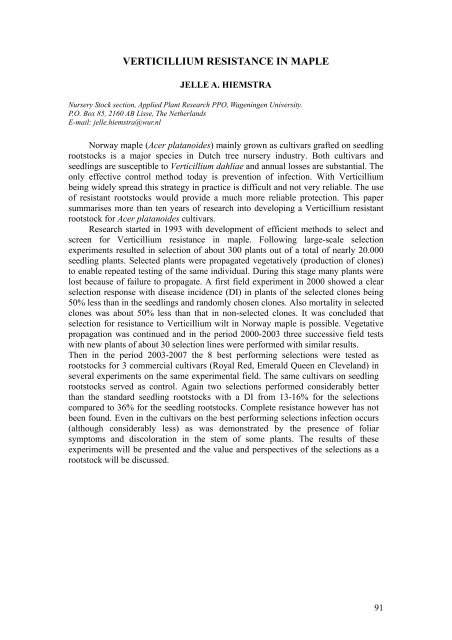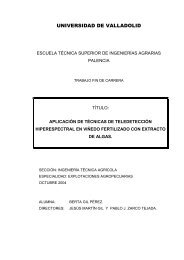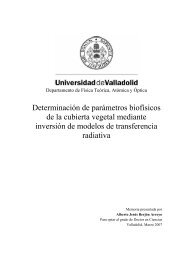10th INTERNATIONAL VERTICILLIUM SYMPOSIUM 16-20 ...
10th INTERNATIONAL VERTICILLIUM SYMPOSIUM 16-20 ...
10th INTERNATIONAL VERTICILLIUM SYMPOSIUM 16-20 ...
You also want an ePaper? Increase the reach of your titles
YUMPU automatically turns print PDFs into web optimized ePapers that Google loves.
<strong>VERTICILLIUM</strong> RESISTANCE IN MAPLEJELLE A. HIEMSTRANursery Stock section, Applied Plant Research PPO, Wageningen University.P.O. Box 85, 2<strong>16</strong>0 AB Lisse, The NetherlandsE-mail: jelle.hiemstra@wur.nlNorway maple (Acer platanoides) mainly grown as cultivars grafted on seedlingrootstocks is a major species in Dutch tree nursery industry. Both cultivars andseedlings are susceptible to Verticillium dahliae and annual losses are substantial. Theonly effective control method today is prevention of infection. With Verticilliumbeing widely spread this strategy in practice is difficult and not very reliable. The useof resistant rootstocks would provide a much more reliable protection. This papersummarises more than ten years of research into developing a Verticillium resistantrootstock for Acer platanoides cultivars.Research started in 1993 with development of efficient methods to select andscreen for Verticillium resistance in maple. Following large-scale selectionexperiments resulted in selection of about 300 plants out of a total of nearly <strong>20</strong>.000seedling plants. Selected plants were propagated vegetatively (production of clones)to enable repeated testing of the same individual. During this stage many plants werelost because of failure to propagate. A first field experiment in <strong>20</strong>00 showed a clearselection response with disease incidence (DI) in plants of the selected clones being50% less than in the seedlings and randomly chosen clones. Also mortality in selectedclones was about 50% less than that in non-selected clones. It was concluded thatselection for resistance to Verticillium wilt in Norway maple is possible. Vegetativepropagation was continued and in the period <strong>20</strong>00-<strong>20</strong>03 three successive field testswith new plants of about 30 selection lines were performed with similar results.Then in the period <strong>20</strong>03-<strong>20</strong>07 the 8 best performing selections were tested asrootstocks for 3 commercial cultivars (Royal Red, Emerald Queen en Cleveland) inseveral experiments on the same experimental field. The same cultivars on seedlingrootstocks served as control. Again two selections performed considerably betterthan the standard seedling rootstocks with a DI from 13-<strong>16</strong>% for the selectionscompared to 36% for the seedling rootstocks. Complete resistance however has notbeen found. Even in the cultivars on the best performing selections infection occurs(although considerably less) as was demonstrated by the presence of foliarsymptoms and discoloration in the stem of some plants. The results of theseexperiments will be presented and the value and perspectives of the selections as arootstock will be discussed.91




